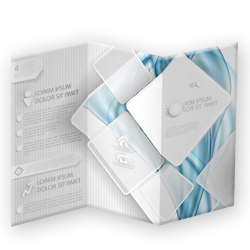A Quick Guide to Designing for Folded Pieces

Everyone has heard the weird facts about folding paper. It's nearly impossible for an average person to fold a piece of paper in half more than seven times without the aid of machinery, but folded thirty times, the paper would reach the upper atmosphere.
If you learned to drive before the era of Google Maps - which I imagine is still most of us - you understand the visceral imagery of trying to unfold and then refold a map the size of your dashboard back into something that fits in a glove compartment. At some point, you give up trying to figure out how it all folded together originally and just sort of smash it together in an awkward, no longer flat mass of paper.
But far more useful than the knowledge that you could measure the universe with folded sheets of looseleaf, is the understanding of how folding paper actually works with print - at least when it comes to design.
When it comes to a folded finished print piece, there are a few things to keep in mind when you're designing for something that has unique or custom folds:
- Folds aren't always equal. If a piece is folding into itself, like a standard trifold brochure, the finished dimensions won't be all the same. Each progressive inside panel should be slightly shorter than the rest, to allow room for the fold itself. This is especially important if your design has defined breaks in image or color along the fold lines - they will not line up properly if you don't account for margins!
- There are many different ways to fold a piece. Bifolds are pretty self explanatory, but z-folds, short, roll and gate folds are all different ways to mix up the design of your print piece without straining the limits of size or paper. A gate fold is one of the hardest to master because of the nature of paper and print variance.
- Think outside the box - but within the paper. A standard 8.5 x 11 trifold is an easy option for a business brochure - but why settle for standard? Our digital presses can print up to a 13 x 19 sheet. If you're having trouble getting your message across with a basic trifold, try changing the page size (keeping the same ratio with fold margins!) to something either larger or smaller depending on your needs.
- Custom folds require special processes. Folds that don't follow the paper edges, or that require more than one direction need to be done using a custom scoring die, and that can be an expensive and time-consuming process. If you've got the budget, go for it - custom folded pieces make a great statement. If not, try and figure out how to get the same effect without needing special finishing!